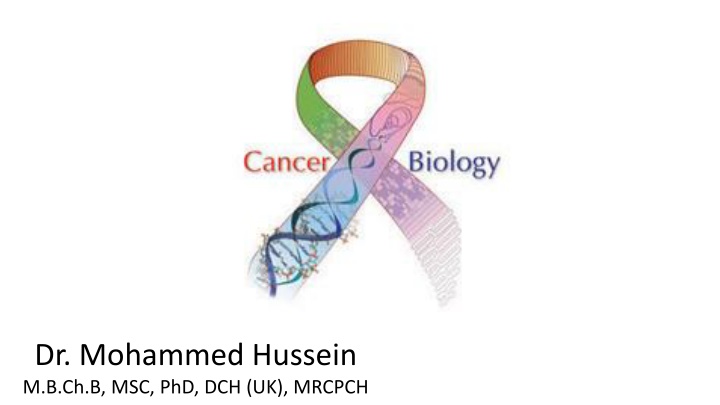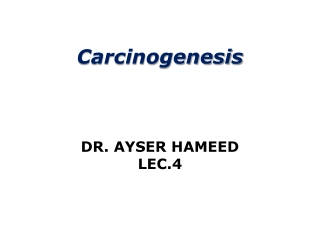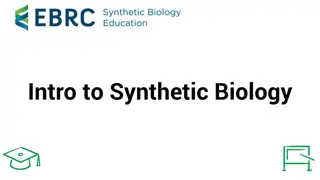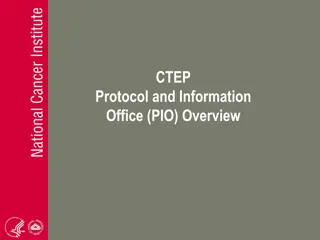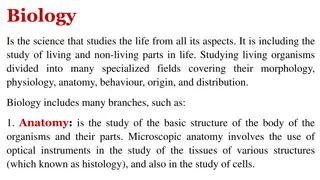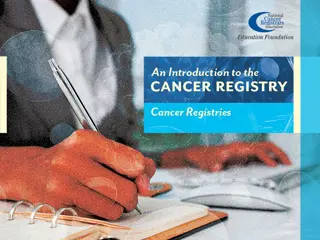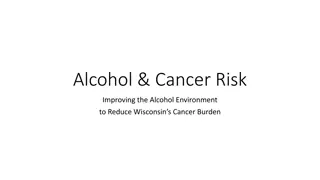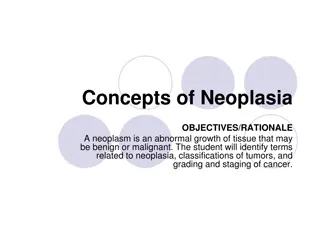Mechanisms of Oncogenesis and Carcinogenesis in Cancer Biology
Various mechanisms leading to genetic changes resulting in uncontrolled cell growth and cancer development include point mutations and chromosomal translocations. Factors like chemical exposure, radiation, and viruses can contribute to carcinogenesis in organisms.
Uploaded on Mar 07, 2025 | 0 Views
Download Presentation

Please find below an Image/Link to download the presentation.
The content on the website is provided AS IS for your information and personal use only. It may not be sold, licensed, or shared on other websites without obtaining consent from the author.If you encounter any issues during the download, it is possible that the publisher has removed the file from their server.
You are allowed to download the files provided on this website for personal or commercial use, subject to the condition that they are used lawfully. All files are the property of their respective owners.
The content on the website is provided AS IS for your information and personal use only. It may not be sold, licensed, or shared on other websites without obtaining consent from the author.
E N D
Presentation Transcript
Dr. Mohammed Hussein M.B.Ch.B, MSC, PhD, DCH (UK), MRCPCH
Mechanism of Oncogenesis Numerous mechanisms exist to create the genetic changes that result in uncontrolled cell growth. 1. Point mutations 2. Chromosomal translocations
Point mutations Point mutations are changes in the individual nucleotides in the gene encoding either proto-oncogenes or tumor-suppressor genes that can result in cancer.
Chromosomal translocations Chromosomal Translocation Malignancy t(8;14) Burkitt lymphoma t(9;22) Chronic myelogenous leukemia t(15;17) Acute myelogenous leukemia
As cells proceed through the multiple rounds of division during the growth and maintenance of the organism, mistakes in the replication of the genome are inevitable. Normally the cells have several DNA repair mechanisms which can overcome these mistakes As the cell is subjected to insults, such as chemicals, radiant energy, or viruses, the normal DNA repair mechanisms may become overwhelmed, leading to the chemical changes that result in mutations. Carcinogen
Carcinogenesis Chemical carcinogenesis Radiation carcinogenesis Viral carcinogenesis
Chemical carcinogenesis Both natural and synthetic compounds are capable of damaging cells either directly, after being acted on by the cell, or in synergy with other chemicals.
Substance Cancer Aniline dyes Bladder cancer Asbestos Mesotheliomas Arsenic Skin cancer Vinyl chloride Angiosarcoma of the liver Nitrosamines (food preservatives) Stomach cancer
Radiation carcinogenesis DNA and other macromolecules are capable of being damaged by different wavelengths of electromagnetic radiation including both 1. UV from the sun is responsible for causing mutations in DNA 2. Ionizing radiation: High-energy radiation (x-rays and gamma rays) causes direct damage to DNA
Viral carcinogenesis Viruses have evolved numerous strategies for promoting the aberrant growth of their host cell types. Human papilloma virus (HPV) Epstein-Barr virus (EBV) Hepatitis B virus (HBV) RNA retroviruses
Human papilloma virus (HPV) Some facilitates the degradation of cellular p53 Others perturb the normal function of the protein Rb.
Epstein-Barr virus (EBV) Promotes the expression of bcl-2, leading to protection from the normal apoptotic pathways that trigger cell death.
Hepatitis B virus (HBV) This virus does not encode any known oncoproteins, its association with human liver cancer has been clearly demonstrated as most likely multifactorial
The cell has evolved several mechanisms for the repair of DNA damaged by the multitudes of insults encountered in the environment. Multiple proteins exist to correct such errors in two major DNA repair pathways: 1. Nucleotide excision repair 2. Mismatch repair
Nucleotide excision repair This occurs through endonuclease cleavage of the damaged bases and restoration of the original segment through the concerted actions of a DNA polymerase
Mismatch repair Sometimes during replication, DNA polymerases insert nucleotides that defy the normal Watson-Crick base pairing (i.e., a G may pair with a T instead of the normal A to T pairing.) Such misspellings need to be recognized and corrected before perpetuation of the error to the next round of division.
Normal Epithelium Loss of APC Hyperproliferative Epithelium Early Adenoma Activation of ras Intermediate Adenoma Loss of tumor suppressor gene Late Adenoma Loss of p53 Carcinoma Other alterations Metastasis
Molecular model of colon carcinogenesis known as the adenomacarcinoma sequence
There are numerous proteins that are overexpressed in cancer cells. Some are actually capable of being detected in the serum of patients with specific cancers. Many of these proteins lack either the specificity or sensitivity needed for their use as screening tests. Their true utility is in monitoring the progression of the disease once confirmed or in monitoring therapy or recurrence
